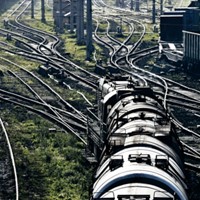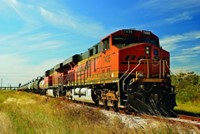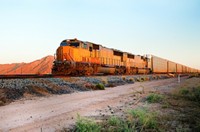Advertisement
Grab your lab coat. Let's get started
Welcome!
Welcome!
Create an account below to get 6 C&EN articles per month, receive newsletters and more - all free.
It seems this is your first time logging in online. Please enter the following information to continue.
As an ACS member you automatically get access to this site. All we need is few more details to create your reading experience.
Not you? Sign in with a different account.
Not you? Sign in with a different account.
ERROR 1
ERROR 1
ERROR 2
ERROR 2
ERROR 2
ERROR 2
ERROR 2
Password and Confirm password must match.
If you have an ACS member number, please enter it here so we can link this account to your membership. (optional)
ERROR 2
ACS values your privacy. By submitting your information, you are gaining access to C&EN and subscribing to our weekly newsletter. We use the information you provide to make your reading experience better, and we will never sell your data to third party members.
Safety
Chemical Shippers decry Rail Monopolies
In pressing for reform of railroad practices, captive customers cite lack of competition
by Glenn Hess
July 10, 2006
| A version of this story appeared in
Volume 84, Issue 28

Unreliable service and high shipping rates charged by the nation's dwindling number of freight railroads are contributing to the increasing cost of chemicals, electricity, and agricultural commodities, critics told a Senate panel last month.
"The system is broken, and Congress needs to fix it," said John L. McIntosh, president of chlor-alkali products for Olin Corp. "Railroad monopolies are driving a golden spike through the heart of American competitiveness."
Testifying before the Surface Transportation & Merchant Marine Subcommittee of the Senate Commerce, Science & Transportation Committee on June 21, McIntosh said captive shippers—those served by only one railroad—are "completely at the mercy of the carrier," and "free and fair market forces no longer ride American rails."
Without competition, rail carriers have no incentive to deliver efficient, predictable service, said McIntosh, who testified on behalf of the American Chemistry Council. "For a captive shipper, regardless of its size or location, the efficient movement of its traffic—in some cases even the very survival of its business—depends on the rates and service provided by that single railroad," he remarked.
McIntosh, along with spokesmen for electric utilities and for wheat growers, pointed to the dramatic consolidation that has occurred since Congress partially deregulated the railroad industry by passing the Staggers Act in 1980.
In 1977, 63 major freight railroads were operating in the U.S. Today, just seven are serving all of North America, and 90% of the rail traffic is handled by five dominant carriers: Norfolk Southern, CSX, Burlington Northern Santa Fe, Union Pacific, and Canadian National.
Railroad mergers inevitably reduce shipper options, McIntosh noted. "Bottlenecks are extended when lines serving captive shippers are acquired by connecting carriers. Efficient service from independent 'bridge' carriers disappears. Competition for service to new industrial sites is reduced or eliminated," he said.
McIntosh pointed out that nearly two-thirds of U.S. chemical facilities that depend on rail to transport their products are served by just one railroad. "You can imagine the difficulty we face when it comes time to negotiate a rail contract or a rail rate for a captive facility," he told lawmakers. "Because we are captive, we have no way to negotiate, beg, or buy reliability."
McIntosh said captive rail rates are often twice as high as competitive rates and captive shippers also pay higher fuel surcharges. "For captive chemical shippers, the 'iron horse' has become a greedy cash cow," he declared. In 2003, Escalation Consultants studied captive versus noncaptive rail rates for several commodity groups. For chemical companies, the average noncaptive rate for each railroad was about $16 to $20 per ton. In comparison, captive chemical rail shipments averaged $33 to $48 per ton, more than twice as much.
Overall freight rates, adjusted for inflation, have actually declined over the past 20 years for most rail customers, according to a preliminary Government Accountability Office (GAO) report released at the hearing. But the same analysis also confirms that captive shippers are "paying significantly higher rates than others."
GAO, the investigative arm of Congress, has been studying rail rates, competition, and freight capacity issues and plans to issue a complete report by September. The preliminary results show that the tonnage of freight traveling under the higher rates that captive shippers are charged has more than doubled since 1985. These shippers paid rates that were at least 200% more than what it actually cost the railroads to operate the lines and move the cargo, according to the report.
"Because of captivity, the cost of transporting grain can represent as much as one-third of the overall price a producer receives for his or her grain," said Dale Schuler, president of the National Wheat Growers Association. "This cost comes directly from a producer's bottom line."
Shippers also took issue with federal oversight of the railroads. National Rural Electric Cooperative Association President Glenn English told the subcommittee that the five major carriers have been allowed under current law to "artificially tighten their monopolistic stranglehold" over captive shippers through practices that restrain competition. "In areas where competition is minimal or does not exist, the federal regulatory watchdog established under the Staggers Act to protect captive rail shippers—the Surface Transportation Board [STB], successor to the Interstate Commerce Commission—has failed to fulfill its responsibility to ensure that rail rates and practices are fair and equitable and in the overall national best interest," he charged.
To prove that a rail rate increase is unjust under STB's current regulations, shippers are required to navigate a legal process that costs several million dollars and takes two to three years to complete. Since STB established the guidelines in 1996, only one chemical shipper has filed a formal rate complaint.
STB Chairman W. Douglas Buttrey said the board is investigating ways to improve rate challenge procedures. "What we concluded is we need to sit down and go over this whole process again and come up with more simplified rules and a fairer process," he told the panel.
Sens. Conrad Burns (R-Mont.) and Byron L. Dorgan (D-N.D.) indicated that lawmakers are out of patience waiting for STB to act. While regulators have listened to shippers' frustrations and reviewed their complaints, the senators said, the board has done little to resolve rate and service disputes. "If there's ever an Olympic event for studying, clearly STB is a gold medal winner," Dorgan remarked. "Clearly, there is a failure."
"I am not interested in re-regulating the railroads, but I am interested in captive markets," Burns added. "There's no excuse why this [captive shipper problem] has not been handled yet. "We were not sent to Congress to idly stand by and oversee a monopoly."
Burns also said the hearing demonstrated the need for legislation he has introduced, the Railroad Competition Act (S. 919), which advocates claim would address anticompetitive practices in the industry and reform STB to provide a workable forum for dispute resolution. "The big railroads have failed to come to the table, so we're going to forge on with legislation," Burns declared.
Edward R. Hamberger, president of the Association of American Railroads (AAR), reminded lawmakers that government regulation of the railroads did not work well in the past. Before passage of the Staggers Act, the industry group has noted, one-fifth of the nation's freight lines were operating in bankruptcy.
Hamberger stressed that a financially healthy rail industry is required to ensure that there is enough rail capacity in the future to meet growing demand for freight. "Not all rail customers seem to recognize that if they want added rail capacity, they must be willing to pay for it," he said.
After enjoying strong profit growth in 2005, the four major U.S. freight railroads plan to spend a record $8 billion on infrastructure investment this year, up from $6.6 billion last year, according to AAR.
Hamberger also insisted that railroads have been holding down transportation costs for most chemical shippers. He challenged chemical companies to name one other part of the supply chain where costs have declined as much as rail transportation rates.
"I don't know of many other industries charging less for their services in 2006 than they did in 1985," Hamberger remarked.
Freight railroads, he said, "do a remarkable job of meeting the needs of an extremely diverse group of shippers. Railroads move tens of thousands of railcars to and from thousands of origins and destinations every day, at rates that shippers elsewhere in the world would love to have."





Join the conversation
Contact the reporter
Submit a Letter to the Editor for publication
Engage with us on Twitter